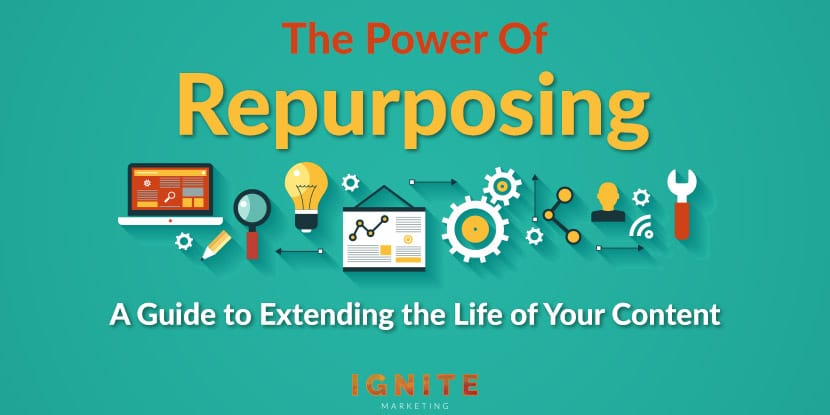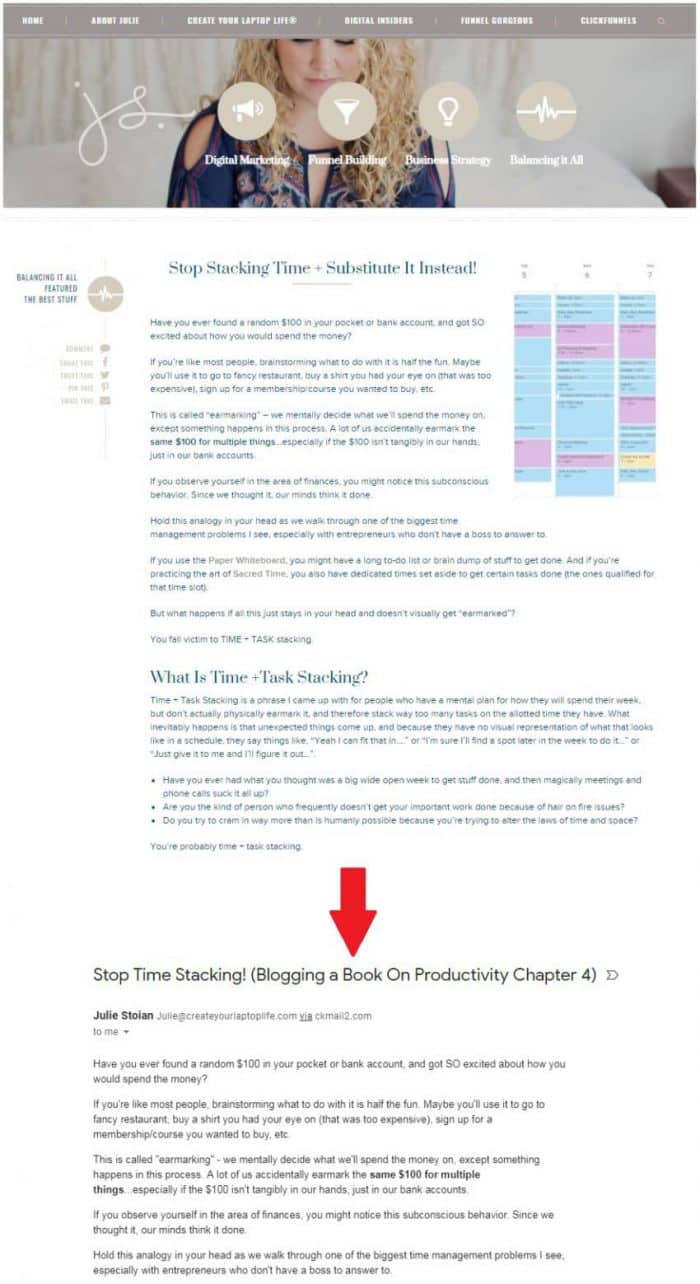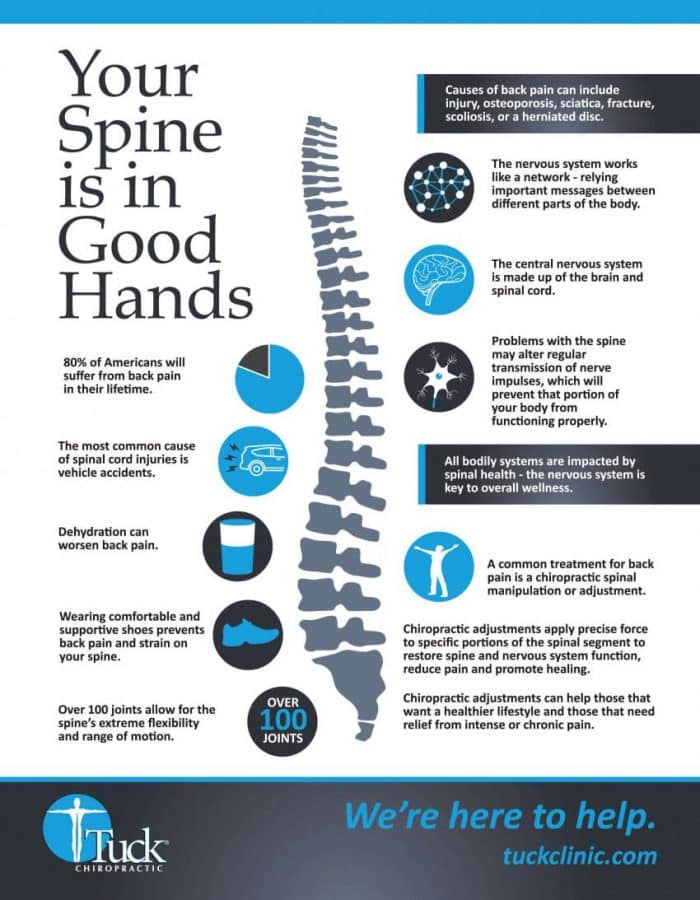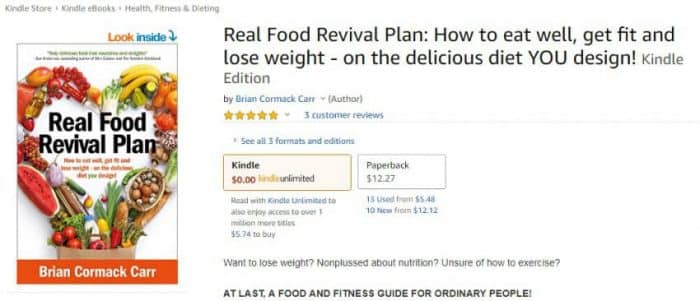


We’re fresh off a blog series on inbound marketing for local businesses and one thing is clear: content is the wind powering your customer acquisition turbine. No content, no customers.
In fact, according to a 2016 Demand Gen Report, 47% of buyers viewed 3-5 pieces of content before even engaging with a sales rep.
A 2015 study by research firm IDC revealed that creative teams were producing 10X more content than 5 years previously while a recent 2019 In-House Creative Management Report indicated that volume and velocity remain two of the greatest challenges for creatives.
Businesses are pumping out more content than ever before, but quality content creation isn’t cheap. It’s time consuming and requires a tremendous amount of effort. What’s more is that it isn’t uncommon to see a decline in traffic once a piece of content’s promotional run is over.
It’s like the Hunger Games for content marketers.

So, what’s a business owner to do?
Whether you review the stats or listen to the experts, there’s a common thread of agreement: the more content you have, the better it is for your business.
Fortunately, there’s a simple way to amplify your efforts and increase productivity without struggling to brainstorm new content ideas, spending a disproportionate amount of your budget on content creation rather than content promotion, or going crazy over the stress of it all.
It’s a little trick called repurposing.
Instead of churning out new content, repurposing allows you to answer the demand for fresh content by revamping and presenting existing content in a new way. It’s like converting a pair of pants into shorts by cutting off the legs. You can essentially breathe new life into dusty old cobwebbed content and derive additional value from pieces that are still highly relevant to your audience.
In this post, we’ll work through some of the best ways to repurpose content. Before we do that, let’s look at the benefits of repurposing.
Content helps you rank in search results, creates awareness for your brand, builds your authority, and drives new customers to your business. Repurposed content takes these benefits to a whole new level and offers a handful of additional advantages.
People have preferences when it comes to the way they consume content and absorb information. While some favor the written word, others respond better to visual or audio content. With that in mind, consider how you can potentially expand your reach into new audiences by simply adapting the format and length of an existing piece to appeal to new prospects. With repurposing, you can basically meet different segments of your target customers where they’re at in all the places they search.
Repurposing can help improve organic visibility and traffic by securing more search ranking real estate. By turning an optimized blog post into multiple pieces of content presented in different formats, you’re effectively generating opportunities to target desired keywords that give your business more ranking juice. For example, a blog post that’s repurposed as a SlideShare presentation can help a business secure two spots within top search results for the same keyword while extending reach into a completely new channel. In addition, pieces that are published off-site have the potential to create backlinks depending on the platform.
There’s an age-old marketing principle called “The Rule of 7.” It argues that prospects need to see your marketing message at least seven times before they’re ready to close the deal. Instead of covering a topic once and then archiving it, repurposing allows you to reinforce your message and drive home crucial points in unique ways while hitting the rule’s quota. It also allows you to be consistent with your message delivery.
Publishing quality content on a particular topic across multiple platforms raises your online profile and garners respect for your expertise in your industry. As your authority grows, you’ll likely find new opportunities to contribute content to communities similar to yours through guest blogs, podcast interviews, and more. Can you say, “Hello new prospects”?
Rather than work harder, repurposing takes your content marketing game up a notch by giving you an easy way to work smarter. Besides easing up your writing schedule, you’re not in a constant state of anxiety figuring out what to write about next, each piece of content you repurpose maximizes its ROI, and you can devote more time and money to other areas of your local business. Your content goes to work for you again and again without you having to put in much additional effort at all.
Now that you know why you should be repurposing content, how do you know which content to give a second chance?
Unfortunately, not all content is worthy of repackaging. This is especially true for content with a short lifespan, including seasonal or topical content like an industry news story. While this type of quick-decay piece can give you instant exposure, it’s unlikely to be as relevant several months down the line. To ensure you’re siphoning out the best content for repurposing, you want to ask yourself several questions:
Evergreen content is content that can theoretically live forever. It’s not reliant on current news, events, trends, or seasons, and it’s as relevant today as it will be a few years from now. For example, this search result for a blog post by a popular gym brand is timeless.
 Although it’s targeted to a segment of their market, there will always be fitness beginners who are looking for gym tips when they’re just starting their health journey.
Although it’s targeted to a segment of their market, there will always be fitness beginners who are looking for gym tips when they’re just starting their health journey.
By contrast, seasonal or topical content declines in relevancy. Take this real estate-related blog post for instance:
 While it would have been relevant for the last few months of 2017 and for a good portion of 2018, it ceased to be relevant once 2019 rolled around. The content had a finite end point.
While it would have been relevant for the last few months of 2017 and for a good portion of 2018, it ceased to be relevant once 2019 rolled around. The content had a finite end point.
There is a caveat when it comes to seasonal content, though. Let’s say a real estate agency or local building company creates content around preparing a home for winter. That kind of content could potentially be relevant for a specified period of time each year. In this case, you’ll need to weigh up whether it’s worth creating an inventory of repurposed content for recurring promotion during those seasons.
The chances are that you’ll find evergreen content is infinitely more valuable than seasonal content. In fact, CoSchedule estimates that evergreen content gets up to 283% more traffic while SEMrush says it could possibly earn 4X what seasonal content earns each year.
Google Analytics can be a great tool for unearthing your most trafficked posts. Since these pieces of content have shown to perform well, they’re likely to be good choices for repurposing.
 Besides evaluating popularity to sort and rank your content, you also want to consider metrics like page views, time on site, social engagement, post engagement, and quantity of shares to ensure you’re identifying the most compelling subject matter for repurposing. Once you sift out these posts, you can then decide how to revamp or repurpose them.
Besides evaluating popularity to sort and rank your content, you also want to consider metrics like page views, time on site, social engagement, post engagement, and quantity of shares to ensure you’re identifying the most compelling subject matter for repurposing. Once you sift out these posts, you can then decide how to revamp or repurpose them.
When browsing through your archives, you might discover content you can update with additional information or repurpose in a way that creates further value. This could include incorporating examples, changing information to reflect industry changes, adding new tips and tricks, weaving in statistics, and more. These pieces could be perfect fodder for both a makeover and repurposed content.
We’re about to dive into some top ways to repackage and reuse content, but one last consideration is how you’ll repurpose it. Some content won’t translate well in a visual context while other pieces might not make the most sense in video or audio format. Keep in mind that even though you’re not developing something from scratch, you are still allocating resources to repurposing, so it must make sense to do it.
On a final note, it’s important to understand that repurposing isn’t just about using the same piece of content over and over again. It’s about altering it in a way that makes it fresh and appealing to a new audience. With that said, let the following repurposing ideas inspire you.
You’ve picked out the pieces you believe deserve a new lease on life. Let’s explore ways you can repackage them…
If your local business’s social media management strategy doesn’t include frequent postings from your blog or ebook archives, then you’re missing out on easy opportunities to not only promote that content but also establish yourself as a go-to resource for your social media followers. Keep in mind that although people might follow you on Facebook, Twitter, Instagram, or any one of the other social platforms you’re active on, they’re not necessarily reading your blog.
Here’s an example of how The Gelb Center repurposes their blog content to create social media snippets for sites like Instagram:
 Most of us are always on the lookout for new ways to craft engaging social media posts when we likely have a pool of relevant content at our finger tips. Here are just a few ideas:
Most of us are always on the lookout for new ways to craft engaging social media posts when we likely have a pool of relevant content at our finger tips. Here are just a few ideas:
The benefit of repurposing content into social media posts is that you increase its shareability and reach while improving social media engagement across profiles. In addition, it’s now in a digestible format for people who just want the highlights. By linking back to the original content, they have an opportunity to find out more if it interests them.
Email marketing forms a crucial part of inbound marketing, but it’s not easy to come up with new email content no matter what stage a consumer is at in the buying cycle. Turning a blog post into a series of helpful emails is the perfect solution to keeping leads, prospects, and customers engaged and your brand top-of-mind.
Here’s an example from Julie Stoian who sends her full blog posts as emails:
 Readers can enjoy the post within their email client or click through to the blog complete with images.
Readers can enjoy the post within their email client or click through to the blog complete with images.
But repurposing blog content for email doesn’t mean you need to share the entire post. You can create roundups of related content, pare the content down into bite-sized chunks, or focus on one specific element per email such as a single tip, hack, strategy, or idea. You can also include snippets in an email newsletter that contains special offers and other content. And if you want to take advantage of a lead generation opportunity, advertise your series as an email course and prompt people to sign up with a compelling CTA.
Infographics and instructographics make for great eye candy while still being excellent educational assets. They’re informative, easy to read, and highly shareable. So, what are they?
An infographic is essentially a summary of the main talking points in your content represented in a visual outline. This format offers a great way to repurpose content with lots of data and facts, reducing long paragraphs to mere bullet points. Here’s an example from Tuck Clinic that provides readers with key insights about back pain, the spinal cord, and chiropractic care as a solution:
 (Source: Tuck Clinic)
(Source: Tuck Clinic)
An instructographic, on the other hand, has a similar look and feel but focuses more on the tutorial aspect of a blog post. Rather than facts and figures, it provides actionable instructions with complementary graphics, making this the ideal format for how-to posts and content with step-by-step processes.
Here’s a brilliant yoga example by PositiveMed:
 (Source: PositiveMed)
(Source: PositiveMed)
Fortunately, you don’t have to be a graphics artist to create attractive visuals that capture attention. Besides hiring a freelance designer from a site like Fiverr, you also have easy DIY options with infographic templates and content creation tools like Piktochat, Infogram, and Canva. The final result doesn’t have to be a masterpiece. It can be as simple as a graph or chart that’s prettified to appeal to people who prefer visual content and consuming data points quickly.
People love podcasts.
According to a Nielsen research report, 50% of all US homes are podcast fans while an Infinite Dial study showed that approximately 51% of the US population has listened to at least one podcast.
The chances are that some members of your target audience prefer audio content over reading, so why not repurpose your written insight into something listeners can enjoy during their commute, gym workout, or grocery run?
Here’s an example from Austin-based realtor, Kurt Duffeck, who does a fantastic job of creating content on a relevant topic and repurposing it for blog, video, and podcast use.
 If you don’t already run a podcast for your local business, The Podcast Host has written an easy-to-follow step-by-step guide on how to start one. The good news is that since you’re repurposing content, you should already have a good portion of your script (or at least talking points you can use). Don’t forget to create show notes or a script for additional pieces of content your audience can download and consume later.
If you don’t already run a podcast for your local business, The Podcast Host has written an easy-to-follow step-by-step guide on how to start one. The good news is that since you’re repurposing content, you should already have a good portion of your script (or at least talking points you can use). Don’t forget to create show notes or a script for additional pieces of content your audience can download and consume later.
One last thing: podcasting can seem like a daunting prospect when you first start out. However, a little strategic planning can help you produce tons of content that can build your authority quickly. For example, start some of your content development with a podcast instead of a blog post. Transcribing an audio file into written content you can later edit and enrich with additional thoughts, graphics, and keywords is a lot easier than starting with a blog post and then repurposing it into your podcast recording. Sometimes conversations with other experts, Q&As, interviews, and simple riffing on a particular subject can produce some of the best stuff for use in all formats.
Video remains one of the most effective content formats in today’s digital marketing landscape. That’s because humans are visual beings and we tend to find videos more engaging and memorable than other forms of content. Not surprisingly, Cisco research predicts that by 2022 video will account for 82% of all consumer online traffic (15X higher than it was in 2017).
For local business owners, video is the perfect channel for storytelling and creating recognition with consumers. Unlike the case with online businesses, prospects and existing patrons will visit your premises and meet you and your employees in person. Video offers the perfect medium for an online introduction.
However, video is another awesome way to capitalize on existing content through repurposing. Following on from our previous podcast example, here’s a YouTube video from the same Austin realtor:
 With this multi-format approach, users can consume the information in the format they prefer.
With this multi-format approach, users can consume the information in the format they prefer.
When you follow this approach, be sure to embed the video into a blog post, as well as upload it to other video sharing platforms like Vimeo. This will expand your reach, drive traffic to your website via multiple sources, and signal to Google that you have some clout and deserve to be ranked accordingly.
Besides being incredibly easy to use, SlideShare is one of the top 100 most-visited sites in the world. It’s an effective tool for creating brand awareness and driving traffic, making it the perfect platform to host a slide deck presentation. More specifically, a slide deck presentation created from one of your top blog posts.
But that’s not the only reason to repackage content this way.
Slide decks are ideal for videos and webinar presentations. Combine the audio from a podcast with a well-designed SlideShare presentation and you have an amazing teaching tool you can use in a variety of situations online.
The creatives at Digital Marketer are pros at turning their blog content into slide deck presentations. Here’s an example of one of their more popular posts on blogging ideas:

The original post is packed full of images, videos, and other elements they can use to promote their content across multiple platforms. It even has an infographic and downloadable PDF version.
When creating your own slides, be sure to pare down key ideas in your blog post into concise sentences and bullet points so that they’re suitable for a slide and any graphics you use. Tools like PowerPoint (online version), Google Slides, Prezi, and Canva, make slide deck creation a breeze.
 eBooks are an authority statement. They boost your credibility, establish your position as an industry expert, and provide your target audiences with value. They also improve your online visibility, increase the potential for going viral, and enhance your reputation and influence. If they’re a paid offering, they can generate profits for years to come, giving you some pretty powerful leverage when you think about it.
eBooks are an authority statement. They boost your credibility, establish your position as an industry expert, and provide your target audiences with value. They also improve your online visibility, increase the potential for going viral, and enhance your reputation and influence. If they’re a paid offering, they can generate profits for years to come, giving you some pretty powerful leverage when you think about it.
Now consider this: if you blog with a purpose in a 9-12 month period, you can essentially repurpose that content into a high-quality book people are willing to buy. All you’d need to do is supplement what you’ve written with additional information, graphics, or other exclusive content.
In fact, we’re currently wrapping up the blogging of a book for Dr. Tony Nalda, an awesome client of ours. To create multiple forms of content effectively and efficiently for a variety of platforms, our sequence of repurposing worked like this:
Step 1: We interviewed Dr. Tony in order to gain the information we required for his scoliosis blog posts.
Outcome: Organic search improvements
Step 2: We then took those blog posts and created image quotes and posts for his Scoliosis Reduction Center Facebook Page.
Outcome: Social reach and engagement
Step 3: We used those images to inspire more content for the center’s Scoliosis HOPE Facebook Group.
Outcome: Community growth and engagement
Step 4: We’re in the process of compiling this content for a book to be published in May 2019.
Outcome: Authority
Step 5: As part of our promotional plan, we tool key parts of the book and created a podcast called The Dr. Tony Nalda Show.
Outcome: Promotion
In this example, Dr. Tony is not just working with us to repurpose content from a single blog, but also amplify his authority and brand as a leading expert in scoliosis through the publishing of his first book.
Pretty cool, right?
Here’s another example of a book that was originally blogged by Brian Cormack Carr before being repurposed and upgraded for Kindle.
 It’s like a gigantic business card people can’t ignore.
It’s like a gigantic business card people can’t ignore.
Now if you’ve been blogging for your local business for any length of time, the likelihood is that you have a book in there. Why not combine related posts and repackage them in the convenient format of an ebook to generate leads or direct revenue for your business?
You have to start thinking about ebook publishing as a component of your inbound channel and how it can 100X your current efforts.
Since you’ve gone through the tremendous effort of researching, crafting, and promoting your content, it only makes sense to squeeze every last drop of value from it. That starts with repurposing.
You might have picked up from some of these tactics that there’s a sweet continuity to it. You can easily create workflows that further standardize the process and save you time. For example, create graphics with concise pieces of text or bullets, combine them into a slide deck, and then record your screen and audio as you narrate the presentation. Suddenly you have images and text snippets for social media posts, a slide deck, audio for a podcast, and a video or pre-recorded webinar.
Remember: smarter, not harder.
How have you tried to extend the life of your content? What were the results? Join the conversation by sharing your tips and stories with us in the comment section below.
